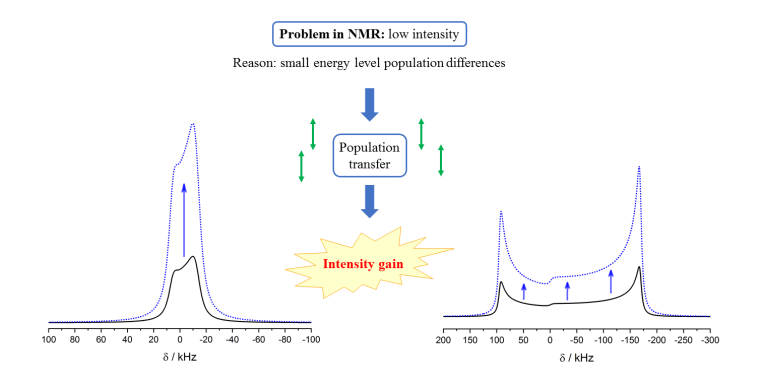Method development for the optimization of one- and two-dimensional 19F-13C solid-state NMR experiments (Max Bußkamp)
In this project, the solid-state NMR method of respiration CP is to be enhanced and optimized for new applications using the NMR simulation program SIMPSON, Matlab and Floquet Theory. The method will mainly be used for the analysis of fluorinated polymers such as Teflon and Kel-F.

© mb 
© mb Improvement of population transfer as signal enhancement technique in the NMR of quadrupolar nuclei (Sandra Haverkamp)
Quadrupole nuclei account for about 75% of all NMR-active isotopes. These nuclei are challenging for NMR spectroscopists due to poor spectral resolution caused by typical low natural abundance of the isotopes. The spectra are often broad and of low intensity, so that they can hardly be distinguished from noise on the common time scale of NMR measurements. The Double Frequency Sweep (DFS) technology provides an opportunity to increase the signal intensity and thus save experimental time as well as improve the spectral resolution. The aim of the project is to improve our understanding of this technology and to make it applicable more general.

© sh Development and optimization of various solid state NMR experiments (Jonas Koppe)
My research focuses on the development and optimization of various experiments in solid-state NMR spectroscopy. The central feature is the use of amplitude and phase modulated pulses (WURST pulses), whose potential is simulated and experimentally investigated.
The findings obtained are used, e.g., for the characterization of various platinum(II) complexes. The acquisition of these spectra is complex due to the large spectral dispersion and can lead to line widths of several hundred kilohertz.

© jk Characterizing dynamic processes in fluorinated polymers via the 19F CSA (Philipp Selter)
In this project dynamic processes in (partially) fluorinated polymers, e.g.PTFE, PCTFE and PVDF, are studied by 19F MAS NMR. Due to the limited molecular mobility in the solid state, different interactions (e.g. chemical displacement) have anisotropic components, which can be determined by suitable NMR experiments. The magnitude and temperature dependence of these anisotropic interactions allow conclusions about the type of dynamic processes.

© ps
